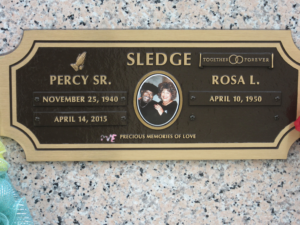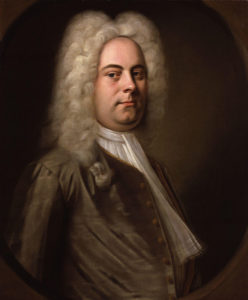 On this day in 1759, Baroque composer George Frideric (or Frederick) Handel died at his home in Brook Street, London, at age 74. Born on 5 March in Halle-upon-Saale, Duchy of Magdeburg (then part of Brandenburg-Prussia). He spent the bulk of his career in London, becoming well-known for his operas, oratorios, anthems, and organ concertos. Handel received important training in Halle-upon-Saale and worked as a composer in Hamburg and Italy before settling in London in 1712. He became a naturalised British subject in 1727. He was strongly influenced both by the great composers of the Italian Baroque and by the middle-German polyphonic choral tradition.
On this day in 1759, Baroque composer George Frideric (or Frederick) Handel died at his home in Brook Street, London, at age 74. Born on 5 March in Halle-upon-Saale, Duchy of Magdeburg (then part of Brandenburg-Prussia). He spent the bulk of his career in London, becoming well-known for his operas, oratorios, anthems, and organ concertos. Handel received important training in Halle-upon-Saale and worked as a composer in Hamburg and Italy before settling in London in 1712. He became a naturalised British subject in 1727. He was strongly influenced both by the great composers of the Italian Baroque and by the middle-German polyphonic choral tradition.
Within fifteen years, Handel had started three commercial opera companies to supply the English nobility with Italian opera. As Alexander’s Feast (1736) was well received, Handel made a transition to English choral works. After his success with Messiah (1742) he never composed an Italian opera again. His funeral was given full state honours, and he was buried in Westminster Abbey in London.
Born the same year as Johann Sebastian Bach and Domenico Scarlatti, in my opinion, Handel is one of the greatest composers of the Baroque era. His works, Messiah, Water Music, and Music for the Royal Fireworks remain steadfastly popular. One of his four coronation anthems, Zadok the Priest(1727), composed for the coronation of George II, has been performed at every subsequent British coronation, traditionally during the sovereign’s anointing. Another of his English oratorios, Solomon (1748), has also remained popular, with the Sinfonia that opens act 3 (known more commonly as “The Arrival of the Queen of Sheba”) featuring at the 2012 London Olympics opening ceremony. Handel composed more than forty operas in over thirty years, and since the late 1960s, with the revival of baroque music and historically informed musical performance, interest in Handel’s operas has grown.
Handel never married, and kept his personal life private.
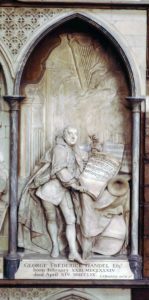
Monument to George Frederic Handel in the south transept of Westminster Abbey. His grave is below.
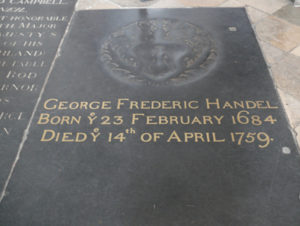 The Final Footprint
The Final Footprint
The last performance he attended was of Messiah. Handel was entombed in Westminster Abbey. More than three thousand mourners attended his funeral, which was given full state honours.
His initial will bequeathed the bulk of his estate to his niece Johanna, however four codicils distributed much of his estate to other relations, servants, friends and charities. Other notable Final Footprints at Westminster include; Robert Browning, Lord Byron, Charles II, Geoffrey Chaucer, Oliver Cromwell, Charles Darwin, Charles Dickens, Edward III, Edward VI, Edward The Confessor, Elizabeth I, George II, Stephen Hawking, Henry III, Henry V, Henry VII, James I (James VI of Scotland), Samuel Johnson, Ben Jonson, Rudyard Kipling, Henry Wadsworth Longfellow, Mary I, Mary II, Mary Queen of Scots, John Milton, Isaac Newton, Laurence Olivier, Henry Purcell, Thomas Shadwell, Edmund Spenser, Lord Alfred Tennyson, Dylan Thomas, and William III.
#RIP #OTD in 1925 American expatriate artist, considered the “leading portrait painter of his generation”, John Singer Sargent died at his Chelsea home of heart disease, aged 69. Brookwood Cemetery near Woking, Surrey, England
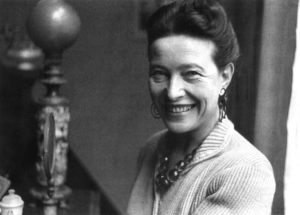 On this day in 1986, existentialist philosopher, public intellectual, social theorist and author, Simone de Beauvoir died of pneumonia in Paris at the age of 78. Born Simone-Ernestine-Lucie-Marie Bertrand de Beauvoir on 9 January 1908 in Paris. Perhaps best known for her metaphysical novels, including She Came to Stay (1943) and The Mandarins (1954), and for her treatise The Second Sex (1949). Also noted for her lifelong polyamorous relationship with Jean-Paul Sartre. Scholarly discussions have analyzed the influences of Beauvoir and Sartre on one another. She is seen as having influenced Sartre’s masterpiece, Being and Nothingness. Yet she wrote much on philosophy that is independent of Sartrean existentialism.
On this day in 1986, existentialist philosopher, public intellectual, social theorist and author, Simone de Beauvoir died of pneumonia in Paris at the age of 78. Born Simone-Ernestine-Lucie-Marie Bertrand de Beauvoir on 9 January 1908 in Paris. Perhaps best known for her metaphysical novels, including She Came to Stay (1943) and The Mandarins (1954), and for her treatise The Second Sex (1949). Also noted for her lifelong polyamorous relationship with Jean-Paul Sartre. Scholarly discussions have analyzed the influences of Beauvoir and Sartre on one another. She is seen as having influenced Sartre’s masterpiece, Being and Nothingness. Yet she wrote much on philosophy that is independent of Sartrean existentialism.
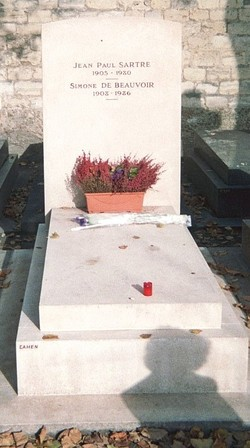 The Final Footprint – Beauvoir is interred with Sartre in the Cimetière du Montparnasse in Paris. In 2006, the city of Paris commissioned architect Dietmar Feichtinger to design a footbridge solely for pedestrians and cyclists across the Seine River. The bridge was named the Passerelle Simone-de-Beauvoir in her honor. It leads to the new Bibliothèque nationale de France. Other notable Final Footprints at Montparnasse include; Charles Baudelaire, Samuel Beckett, Emmanuel Chabrier, Henri Fantin-Latour, César Franck, Guy de Maupassant, Adah Isaac Menken, Man Ray, Camille Saint-Saëns, Jean-Paul Sartre, Jean Seberg, and Susan Sontag.
The Final Footprint – Beauvoir is interred with Sartre in the Cimetière du Montparnasse in Paris. In 2006, the city of Paris commissioned architect Dietmar Feichtinger to design a footbridge solely for pedestrians and cyclists across the Seine River. The bridge was named the Passerelle Simone-de-Beauvoir in her honor. It leads to the new Bibliothèque nationale de France. Other notable Final Footprints at Montparnasse include; Charles Baudelaire, Samuel Beckett, Emmanuel Chabrier, Henri Fantin-Latour, César Franck, Guy de Maupassant, Adah Isaac Menken, Man Ray, Camille Saint-Saëns, Jean-Paul Sartre, Jean Seberg, and Susan Sontag.
#RIP #OTD in 1995 singer (“A Little Bitty Tear”, “A Holly Jolly Christmas”) musician, actor (The Big Country, Cat on a Hot Tin Roof), author, Burl Ives died from oral cancer at his home in Anacortes, Washington, aged 85. Mound Cemetery, Hunt City Township, Jasper County, Illinois
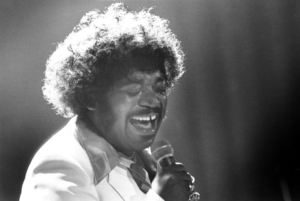 On this day in 2015, R&B, soul and gospel singer Percy Sledge died of liver cancer at his home in Baton Rouge, at the age of 73. Born Percy Tyrone Sledge on November 25, 1941 in Leighton, Alabama. Perhaps best known for the song “When a Man Loves a Woman”, a No. 1 hit on both the Billboard Hot 100 and R&B singles charts in 1966. It was awarded a million-selling, Gold-certified disc from the RIAA.
On this day in 2015, R&B, soul and gospel singer Percy Sledge died of liver cancer at his home in Baton Rouge, at the age of 73. Born Percy Tyrone Sledge on November 25, 1941 in Leighton, Alabama. Perhaps best known for the song “When a Man Loves a Woman”, a No. 1 hit on both the Billboard Hot 100 and R&B singles charts in 1966. It was awarded a million-selling, Gold-certified disc from the RIAA.
Having previously worked as a hospital orderly in the early 1960s, Sledge achieved his strongest success in the late 1960s and early 1970s with a series of emotional soul songs. In later years, Sledge received the Rhythm and Blues Foundation’s Career Achievement Award. He was inducted into the Rock & Roll Hall of Fame in 2005.
Sledge married twice and was survived by his second wife, Rosa Sledge, whom he married in 1980.
The Final Footprint
Baton Rouge’s Heavenly Gates Cemetery.
Have you planned yours yet?
Follow TFF on twitter @RIPTFF

